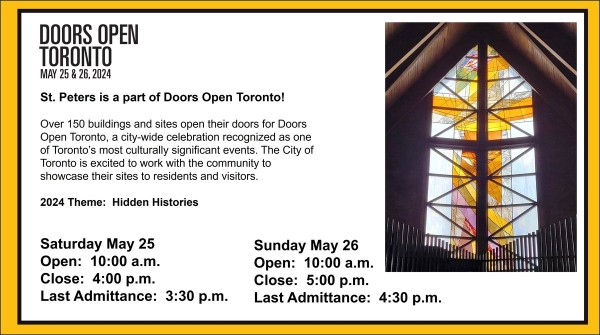Estonians abroad have always called Hallowe’en mardipäev (St. Martin’s Day), for even though the latter is not until Nov. 10, the custom of running from household to household begging for treats is basically the same. Estonia’s tradition is more archaic in look: mardisandid (Mart beggars / “cripples”, dependant on the mercy of others) dress the part and are grimy, dishevelled and under a mountain of vests, coats and hats. They sing about their bad lot: „Laske sisse mardisandid, Mardi küüned külmetavad, Mardi varbad valutavad – Let the mardisandid in, Mart’s nails are freezing, Mart’s toes are aching“. The name Martin is by no means unfamiliar to Estonians, but Mart was quickly derived and favoured as a more palatable short form, becoming one of the more common Estonian names.
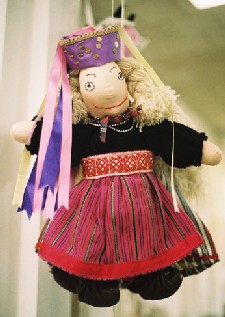
Fly Kadri, fly! Hanging by the entrance to the children’s handicraft-making area at the MARDILAAT (St. Martin’s Day Fair) in Tallinn, this doll enticed children to come and pick up a needle and thread. Or a stick, or a reed.
Both boys and girls trick or treat, which is called „running Mart“ (marti jooksma) but the girls have their own day as well, just two weeks later on Nov. 25 in the form of kadripäev (St. Katherine’s Day). Kadrid usually dress in white, more in the guise of spirits and are called kadrisandid or hingesandid (kadri- or spirit beggars). Mardid are thought to bring luck to the farmer (men’s work) while Kadrid will protect the herd (women’s work), so no hunting or slaughtering allowed on her day!
All of this running is actually done on the eve of the forthcoming day: like All Hallow’s Eve to All Saints Day (pühakutepäev), Mardid also dash on the eve of the 9th and Kadrid on the 24th. This eve is referred to as the laupäev or “Saturday” of the holiday itself, hence jõululaupäev (Christmas Eve) and mardilaupäev. Today the tradition of going door to door is more common in (safer) towns and villages, where people know one another but I did meet a crowd of creepy beggars at the entrance to my 8-story midtown apt. building this year.
Hallowe’en has also steadfastly made its way to continental Europe. Although it seems to be celebrated mainly in pubs by North American / British expatriates, trinkets of witches and jack-o-lanterns made in China have arrived. Luckily they are generally looked upon as foreign in countries with their own, age-old versions of “souling”.
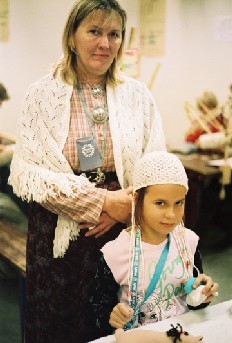
Friida is sewing a big blue nose onto her stuffed kitty-cat at the children’s handicraft area of the Mardilaat. On hand to help is Margit Sondberg of the Estonian Folk Art Club – Eesti Rahvakunstiklubi.
A candle in the window on Nov. 2
The entire month of November and in some places up until Christmas is called hingedeaeg – the time of the spirits. Hingedepäev (Spirits Day) on Nov. 2 is marked by people going to the cemetery to place candles on the graves of loved ones. They may also light a memorial candle at home and even place them on the window for the spirits to find their way home, since this is when old friends come back to visit. One of the old names for November is kooljakuu – month of the dead and there is also a melding of the old Catholic saint day for Martin(us) and another old Estonian synonym for death Mardus, also apparent in the Finnish name for the 11th month – marraskuu, which also means month of the dead.
People used to heat their saunas and leave food out on the table on Nov. 2, so the visiting deceased family members would feel at home. It was generally a quiet time: shouting was discouraged, the house was tidied and quiet preparations were made for winter.
There is no better time for a fall fair (if you keep the dancing and singing low-key), but not in the sense of North American fairs with pumpkins and other fresh produce. In Estonia everything is pickled and preserved by November and the annual MARDILAAT, “Mart’s Fair”, held at the Tallinn Song Festival grounds (more precisely the halls behind the song stage) is more of a winter-hoarding event in every sense of the word.
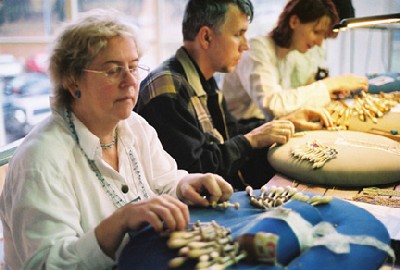
The theme of this year’s Mardilaat was lace (PITS) and here we see one of the more challenging forms of weaving bobbin lace (NIPLISPITS / NIPLAMINE). Each thread is attached to a small pillow on one end and a bobbin on the other. A pair of bobbins is either crossed or twisted without the use of knots, explained teacher and author of a recent book on the subject Eeva Talts (left), who is also a member of the board of the folk art and handicraft association organising the fair. Bobbin lace is used to adorn the cuffs, blouses (KÄISED) and headdresses of many local national costumes.
Maavillane – salt (or in this case wool) of the earth
This was the 9th year for the very successful 4-day event, awaited by all fans of home-grown, practical and health-promoting products, but it’s not only the best place to start your Christmas shopping. The fair is organised by the Estonian Folk Art and Handicraft Association (Eesti Rahvakunsti ja Käsitöö Liit), the people whose Eesti Käsitöö shops are in many places in Tallinn’s old town and who also organise the many smaller, summer fairs held in the Town Hall Square. They promote, instruct and organise competitions. Fall’s Mardilaat is a good place to find out about groups and schools teaching traditional crafts and to learn a thing or two from the vendors. There are instructors on hand to keep kids and other enthusiasts busy making Christmas decorations out of reeds or weaving lucky stars to hang in your window. Traditional goodies available include moose meat and blood sausage and Mulgi porridge (mashed potatoes with barley and meat) which you can enjoy while watching the performances of traditional song and dance. I was busy stuffing a toy bear when a group of feisty, well-set older ladies began roaming the premises, wearing masks and singing old kadripäeva songs.
As a gage, (keeping in mind that approximately 10 EEK = 1 CAD), my purchases included: a wall calendar of local herbal plants - 35 kroons; woollen socks for Canadian friend’s newborn - 45 kr; hand-made Christmas tree ornaments, a strawberry of worked felt (viltimine) - 10 kr and a star made of rye stalks - 20 kr; sea buckthorn (astelpaju) marmalade - 35 kr; musi mesi (kiss honey) lip balm - 25 kr; linseed oil - 40 kr; creamy-white woollen mittens from Hiiumaa - 100 kr and a buckwheat husk pillow - 118 kr. I had just enough left over for a cup of salted beans and a slice of fatty smoked meat on black bread.
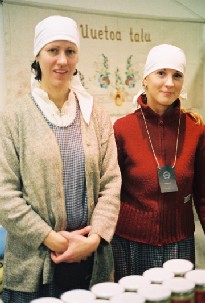
Tiina Kivipõld and Silja Jaska of Uuetoa farm in the county of Viljandimaa convinced people of the wonders of the buckwheat husk pillow: it maintains its shape supporting the neck and head, stays cool and can be used by people allergic to dust mites (TOLMULESTAD). They were also selling their own honey and barley, flour and semolina, all made from the farm’s organically-grown buckwheat (TATAR). This grain does not only grow in Ukraine! Photos: Riina Kindlam







